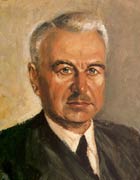Karl Wenschow (1884–1947) [1]

Karl Wenschow was a German sculptor and cartographer who in about 1920 developed a method to quickly create a large amount of accurate terrain models made of paper. He used a pantograph to translate the two-dimensional contour lines of a map into a three-dimensional model, milled out by a cutter from a plaster block. The main intention of these plaster models was to create shaded reliefs for maps, but his factory in Munich was also the biggest producer of terrain models before and during World War II. At the end of World War II, his factory contained 24 pantographs and two presses [2]. Tough moulding paper with an imprinted map was pressed into form by the use of positive and negative dies cast from a master model [3].
[1] Lifedates from http://de.wikipedia.org/wiki/Karl_Wenschow, version of 16.3.2006. Portrait photo from http://www.wenschow.de
[2] Reed, Harrison P.. The development of terrain model in the war. 1946. p.632-652.
[3] Reed, Harrison P.. The development of terrain model in the war. 1946. p.650. Spooner, Charly S. Jr. Modernization of terrain model production. 1953. p.61. Gygax, Fritz. Das topographische Relief in der Schweiz. 1937. S.82,83.
